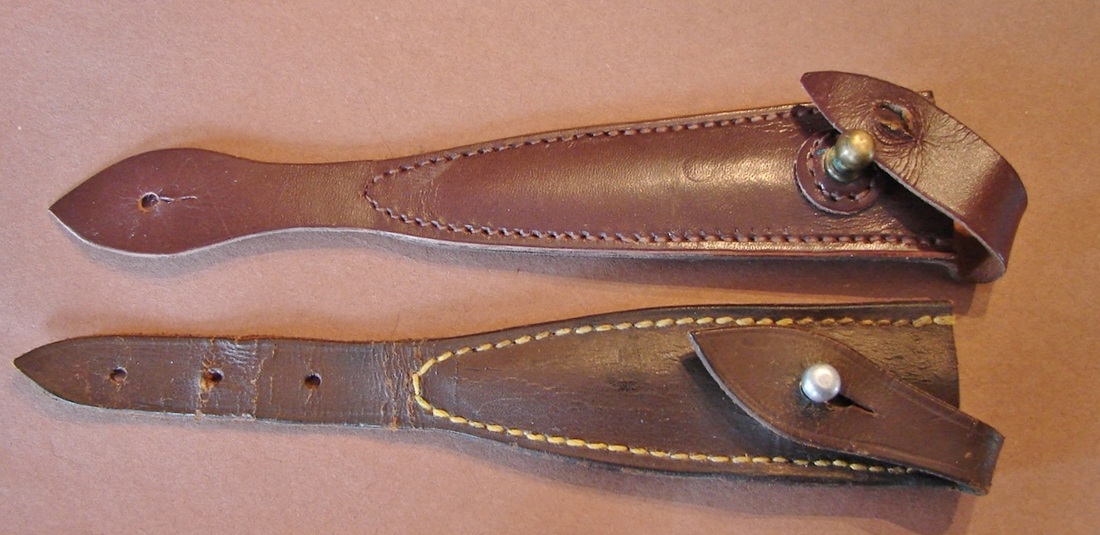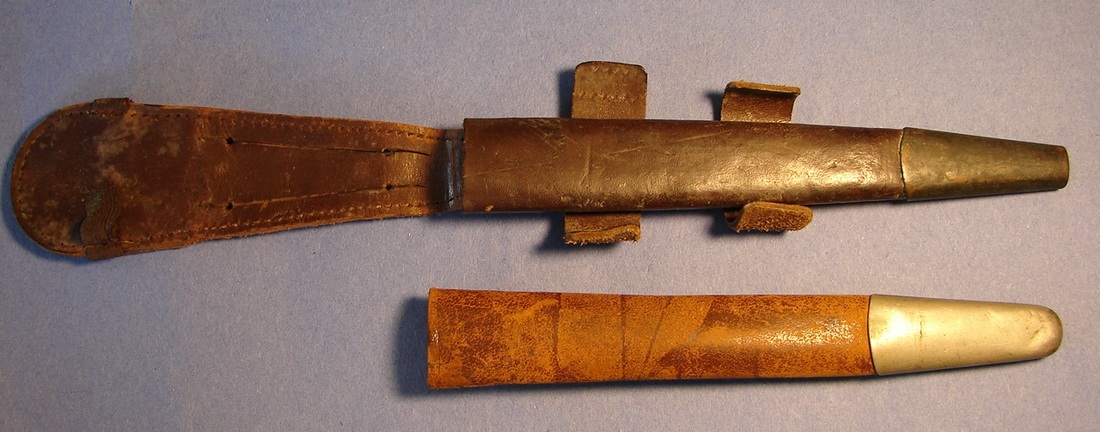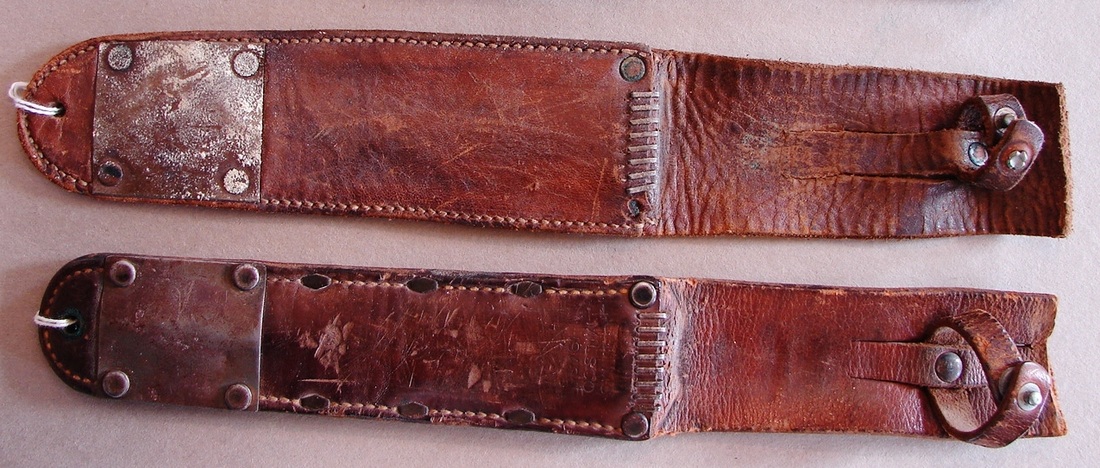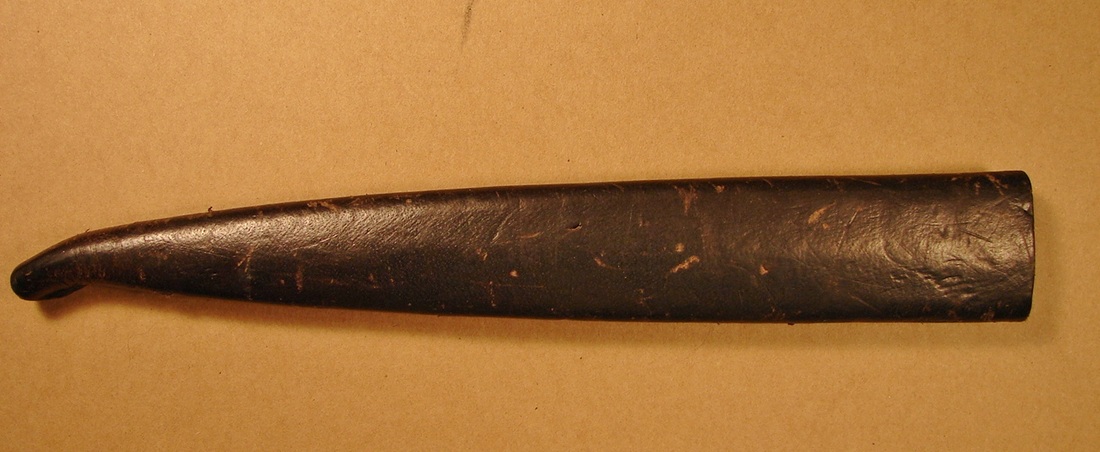Shanghai Daggers
Below: Two Shanghai Dagger sheaths dating from the 1930s. I do wonder if the top one might be a later replacement though. They were designed for upside down under the arm pit
F-S Sheaths:
The original F~S sheaths are a very elaborate construction. They were in some instances made in a cottage industry setting where the cut-to-shape pieces were dropped off and sewn up sheaths were later picked up. Similar in design to bayonet scabbards of the 19th and early 20th century they used a center back seam and a metal chape. Chapes were retained by a rivet or a staple. With the early sheaths, the belt frog (with simple belt slits), was sewn to the sheath body. Later models sometimes had the frog riveted in place to strengthen it. Sometime after the initial run of sheaths, the four tabs were added allowing the sheath to be sewn into a pocket or onto the soldier's gear. The first sheaths used the leather retention strap and snap as shown here. Later versions used narrow brown elastic, which soon stretched out or broke. The last version, post-war, replaced the narrow brown elastic with a broader piece of black elastic. Between the frog coming away from the body of the sheath, or the elastic not retaining the knife properly, many a knife was lost. The design remains unchanged today and for the most part the sheaths are of very poor fit and quality unless they come from a custom maker.
First Pattern sheaths used a leather strap and "Newey" glove snap for knife retention. The retention system was changed to a thin elastic band somewhere around the introduction of the Second Pattern knife. The slender elastic band was prone to stretching and breakage. First Pattern sheaths had a nicely formed and nickel plated chape to prevent the tip of the blade from pushing through and injuring the wearer. The chape was rounded on the end. A few sheaths (illustrated below) have been found, primarily with P-1s that had an odd, open ended, brass ferrule which was known for falling off, being neither riveted nor stapled in place. On this version the frog was crudely stapled in place!
Second pattern sheaths are found with either nickled or blackened chapes, depending on the date of issue. Undoubtedly those left over from P-1 production were used for P-2 knives until the stock was used up. There are examples of square tipped and rounded chapes. Some chapes are held on by a
rivet while others use a metal staple. Some of the variant knives had sheaths without a chape and were simply sewn all the way to the end. Because the sheaths were not hand-fitted to the individual blade you may find a knife that will not seat fully into the sheath and others that rattle around in their sheath. Tight sheaths often suffered being cut at the throat from jamming the knife in, or drawing it out.
Below:The top sheath is a standard P-2 type in typical condition, while the bottom one is a rarer variety (usually found with Fatman knives) with a white metal tip. Unfortunately the lower one, which came with one of the Fatman knives, has the frog missing.
rivet while others use a metal staple. Some of the variant knives had sheaths without a chape and were simply sewn all the way to the end. Because the sheaths were not hand-fitted to the individual blade you may find a knife that will not seat fully into the sheath and others that rattle around in their sheath. Tight sheaths often suffered being cut at the throat from jamming the knife in, or drawing it out.
Below:The top sheath is a standard P-2 type in typical condition, while the bottom one is a rarer variety (usually found with Fatman knives) with a white metal tip. Unfortunately the lower one, which came with one of the Fatman knives, has the frog missing.
Leather tabs were sewn to the back seam to allow the owner to sew his sheath to his battle dress or gear. Often as not these tabs were either removed or left unused. It is not uncommon to find a sheath that is exceedingly long, evidently due to improper cutting of the leather or a bad pattern. The general quality of the construction and the leather used for the sheaths was exceptional. Many of these knives have been safely stored in their original sheaths for over seventy years without incurring any rust. Any rust that has occurred is usually due to improper storage (in a damp area) or a sheath made in India.
Optionally: many owners obtained better/stronger sheaths to replace the somewhat fragile originals. Hard plastic American bayonet scabbards were popular. American M-6 sheaths were also used, as were professionally shortened bayonet scabbards of British manufacture. Near the end of the war we begin to see the flat “commercial sheaths” showing up. These are nothing more than two pieces of leather slapped together with a few rivets set in the seams and then stitched up the sides. A few of them copied the M-6 by adding protective metal plates on the lower end of the leather. Today the dollar value of a knife is often influenced by the presence and condition of its original sheath.
Rare and Unusual Austrailan Commando Sheath: made of quite thin leather, most of the examples I have seen have either dried out and shrunk, or are torn in the corners of the throat. This example is stamped "D D" with a broad arrow between them.
X-Daggers: This style of sheath has been found on some of the X-daggers. The style closely resembles that of the Australian sheath shown above.
Below: Sheath from X-dagger with thumb recess in the guard. It appears to be from the same maker as the following sheath
Below: The green baize-lined Sheath from the X-dagger with the three inch guard. The sheath's frog is stamped for Gieves and Hawkes.
Post-war sheaths :are mostly pretty dismal affairs. They tend to be very poor fitting, allowing the knife to wallow around inside an ill formed, oversized tube of too thick (or too thin) leather, capped off with a flattened, poorly fitting, brass chape at one end and a thick clumsy frog at the other end. The frog is fitted with a very wide elastic band which is often sewn too short and therefore leaving little give to the material. Sheaths from China or India have a noticeably tapered shape terminating in a sharply pointed triangular chape. The chapes are made of thin flimsy metal and poorly blackened. Today this is the average quality sheath.
Below: French LeCommando sheath shown below. Shown from the back with its unique metal boot-belt clip. These are a high quality sheath.
Below: The following photo shows two M-6 American Style sheaths. The top one is (I believe) a clumsy copy of the original (lower) sheath.
Below: The following sheath came with the brass hilted, theater built knife shown under "cast hilt knives". It is professionally sewn and fitted although it is without a chape or any indication it ever has a frog (hanger).
Below: This is the standard sheath for Egyptian Commando Knives.
Below: Very high quality leather sheath for a Carl Eickhorn P-3. Probably one of the better made sheaths on any modern commando knife.
Below: An example of an X-dagger sheath that has appeared with several knives. It incorporates a sliding leather loop which slips down over the pommel to secure the knife in the sheath. Well made of hiigh grade leather.
















